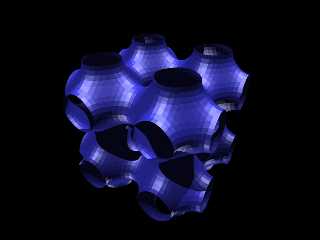 |
 |
|
 |
|
 |
|  |
|  |
|
 |
|
 |
|  |
|  |
|
 |
Just fiddling around with methods to approximate isos using triangle meshs
based on the algorithm described here
http://astronomy.swin.edu.au/~pbourke/modelling/polytetra/, 27s to render 9m
27s to parse using 40 segments along each axis, and 68124 triangles in
total. I'm bundling it all up into an include file, I would image given the
ability to save the mesh so it dosen't have to be reproduced every time
would make it handy for test renders of scenes that are heavy with isos.
Mind you, there is only a noticable speed increase when using complex
functions,
I rendered the iso f(x,y,z) = cos(2*pi*x) + cos(2*pi*y) + cos(2*pi*z) and it
took the same amount of time as the mesh (27s).
--
Kevin
http://www.geocities.com/qsquared_1999/
#macro _(r)#if(r<12)#local i=asc(substr("oqshilacefg"
,r,1))-97;disc{<mod(i,7)-3,div(i,7)-1,6>,z,.4
pigment{rgb 10}}_(r+1)#end#end _(1)//KL
Post a reply to this message
Attachments:
Download 'field.jpg' (85 KB)
Preview of image 'field.jpg'

|
 |
|  |
|  |
|
 |
|
 |
|  |
|  |
|
 |
Kevin Loney wrote:
> Just fiddling around with methods to approximate isos using triangle meshs
> based on the algorithm described here
> http://astronomy.swin.edu.au/~pbourke/modelling/polytetra/, 27s to render
> 9m 27s to parse using 40 segments along each axis, and 68124 triangles in
> total. I'm bundling it all up into an include file, I would image given
> the ability to save the mesh so it dosen't have to be reproduced every
> time would make it handy for test renders of scenes that are heavy with
> isos.
Very nice. Keep going. In the past, I often removed isosurfaces from the
scene for test renderings. An easy way to get an approximation is a nice
thing to have.
Thomas
Post a reply to this message
|
 |
|  |
|  |
|
 |
|
 |
|  |
|  |
|
 |
> Just fiddling around with methods to approximate isos using triangle meshs
> based on the algorithm described here
> http://astronomy.swin.edu.au/~pbourke/modelling/polytetra/, 27s to render
9m
> 27s to parse using 40 segments along each axis, and 68124 triangles in
> total. I'm bundling it all up into an include file, I would image given
the
> ability to save the mesh so it dosen't have to be reproduced every time
> would make it handy for test renders of scenes that are heavy with isos.
> Mind you, there is only a noticable speed increase when using complex
> functions,
> I rendered the iso f(x,y,z) = cos(2*pi*x) + cos(2*pi*y) + cos(2*pi*z) and
it
> took the same amount of time as the mesh (27s).
If you decrease the amount of triangles, it would render a great deal
faster, with the obvious loss of detail, right? And if you didn't need the
parsing time either.. What about using vertex normals / smooth triangle ?
Maybe that could remove the need for isosurface all together in some
situations?
This is very interesting stuff, keep us posted!
-Peter
Post a reply to this message
|
 |
|  |
|  |
|
 |
|
 |
|  |
|
 |




![]()